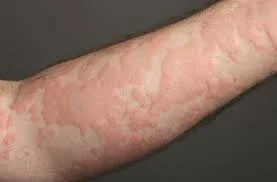Urticaria: A Complete Guide to Understanding and Managing Hives
Urticaria, commonly known as hives, is a skin condition that causes raised, itchy bumps called wheals to appear suddenly on the skin. This condition affects people of all ages and can range from a minor inconvenience to a serious medical concern requiring immediate attention.
What is Urticaria?
Urticaria is a group of skin disorders that all share the same distinctive pattern – the rapid appearance of wheals and sometimes deeper swelling called angioedema. Understanding urticaria properly is important because correct diagnosis leads to better treatment and improved quality of life for patients.
Key Features of Urticaria Wheals
Every urticaria wheal has three main characteristics:
Central swelling: A raised bump that can be small or large, almost always surrounded by red, inflamed skin
Itching or burning: Most wheals cause intense itching, though some may burn or sting instead
Temporary nature: Individual wheals typically disappear within 1-24 hours, leaving normal-looking skin behind
Angioedema in Urticaria
Angioedema often occurs alongside urticaria and has different features:
- Sudden, deep swelling in the lower layers of skin
- May cause pain instead of itching
- Often affects mucous membranes (lips, eyelids, throat)
- Takes longer to resolve – up to 72 hours
- Can be dangerous if it affects breathing
How Urticaria Develops
Urticaria occurs through a process called local vasodilation, where blood vessels in the skin widen and become leaky. This allows plasma (the liquid part of blood) to escape into surrounding tissues, creating the characteristic swollen wheals. The size, number, and shape of wheals can vary greatly from person to person and even in the same person at different times.

What Happens in the Skin
When doctors examine urticaria tissue under a microscope, they see:
- Swelling in the upper and middle layers of skin
- Widened blood vessels and lymphatic vessels
- Inflammatory cells including neutrophils, eosinophils, and lymphocytes
- Increased numbers of mast cells (cells that release histamine)
Classification of Urticaria
Urticaria is classified based on several factors: how long it lasts, how often it occurs, how severe it is, and what causes it.
Main Types by Frequency
Spontaneous Urticaria (80% of cases):
- Acute urticaria: Wheals lasting less than 6 weeks
- Chronic urticaria: Wheals occurring for more than 6 weeks
Physical Urticaria (10% of cases):
- Triggered by physical factors like cold, heat, pressure, or sunlight
Special Forms (10% of cases):
- Includes contact urticaria, exercise-induced urticaria, and water-induced urticaria
Detailed Classification
Acute Urticaria: Spontaneous wheals that appear and disappear within 6 weeks. Often caused by infections, medications, or allergic reactions.
Chronic Urticaria: Wheals that persist for more than 6 weeks, usually appearing daily or almost daily.
Physical Urticaria Types:
- Cold contact urticaria: Triggered by cold air, water, or wind
- Delayed pressure urticaria: Caused by sustained pressure, with wheals appearing 3-8 hours later
- Heat contact urticaria: Triggered by localized heat
- Solar urticaria: Caused by UV or visible light exposure
- Dermographic urticaria: Caused by scratching or rubbing the skin
- Vibratory urticaria: Triggered by vibrating tools or equipment
Other Urticaria Forms:
- Aquagenic urticaria: Triggered by water contact
- Cholinergic urticaria: Caused by increased body temperature
- Contact urticaria: Triggered by touching specific substances
- Exercise-induced urticaria: Caused by physical exercise
Measuring Urticaria Severity
Healthcare providers use scoring systems to track how severe urticaria is and how well treatments are working.
Standard Scoring System
Wheals Score:
- 0: No wheals
- 1: Mild (fewer than 20 wheals in 24 hours)
- 2: Moderate (21-50 wheals in 24 hours)
- 3: Intense (more than 50 wheals in 24 hours or large connected areas)
Itching Score:
- 0: No itching
- 1: Mild itching
- 2: Moderate itching
- 3: Intense itching
The total score ranges from 0-6, helping doctors understand disease activity and treatment response.
Since urticaria symptoms change throughout the day, patients are often asked to keep daily records for several days to get an accurate picture of their condition.
Diagnosing Urticaria
Proper diagnosis of urticaria starts with a thorough evaluation that includes detailed history-taking, physical examination, and appropriate testing.
Essential History Questions
Doctors need to understand several aspects of the condition:
Timing: When did the urticaria start? How long do individual wheals last?
Pattern: Do wheals appear at certain times of day? Is there a pattern related to activities?
Appearance: What do the wheals look like? Where do they appear on the body?
Associated symptoms: Is there angioedema? Any breathing problems?
Triggers: What medications, foods, or activities happened before the wheals appeared?
Family history: Does anyone in the family have urticaria or allergies?
Personal history: Any known allergies, infections, or other medical conditions?
Lifestyle factors: Work environment, hobbies, stress levels, menstrual cycle relationship
Physical Examination
During examination, doctors look for:
- Active wheals and their characteristics
- Signs of angioedema
- Evidence of scratching or secondary infection
- Overall health status including blood pressure and breathing
Laboratory Testing
Testing recommendations vary by urticaria type:
Acute Urticaria: Usually no testing needed unless specific causes are suspected
Chronic Urticaria: May include:
- Blood count and inflammation markers (ESR, CRP)
- Tests for infections if suspected
- Allergy testing in selected cases
- Autoantibody testing
- Thyroid function tests
Physical Urticaria: Specific provocation tests:
- Ice cube test for cold urticaria
- Pressure testing for delayed pressure urticaria
- Light testing for solar urticaria
- Dermographism testing by scratching the skin

Understanding Acute vs. Chronic Urticaria
Acute Urticaria
Acute urticaria often has identifiable triggers:
Common Causes:
- Upper respiratory infections (colds, flu)
- Urinary tract infections
- Medications, especially NSAIDs (aspirin, ibuprofen)
- Food allergies in people with other allergic conditions
- Insect stings
Diagnosis approach: Focus on identifying and removing triggers through careful history-taking and physical examination.
Chronic Urticaria
Chronic urticaria is more complex and often has unknown causes:
Possible Triggers:
- Chronic bacterial infections (H. pylori, dental infections)
- Autoimmune conditions
- Thyroid disorders
- Chronic stress
- Food additives (though food allergies are rare in chronic urticaria)
The frequency of different causes varies by geographic region. For example, hepatitis infections commonly cause chronic urticaria in southern Europe but rarely in northern Europe.
Treatment Approaches
Acute Urticaria Treatment
First Steps:
- Identify and avoid suspected triggers
- Discontinue suspected medications
- Treat any underlying infections
Medications:
- Non-sedating antihistamines as first-line treatment
- May use up to 4 times the normal dose if needed
- Treatment typically continues for 1-2 weeks
Severe Cases:
- Oral corticosteroids (prednisolone 100-250 mg) for severe angioedema
- Intravenous antihistamines in hospital settings
- Emergency epinephrine for life-threatening reactions
Hospital admission needed for:
- Breathing difficulties
- Low blood pressure
- Severe widespread urticaria
- Dangerous angioedema affecting the throat
Related Conditions
Several conditions are historically related to urticaria or can be confused with it:
Conditions that mimic urticaria:
- Urticaria pigmentosa (mastocytosis)
- Urticarial vasculitis
- Familial cold urticaria (actually a form of vasculitis)
- Hereditary angioedema (HAE)
Syndromes that can include urticaria:
- Muckle-Wells syndrome
- Schnitzler’s syndrome
- Gleich’s syndrome
- Well’s syndrome
Living with Urticaria
Daily Management
For all types:
- Take medications as prescribed, even when symptoms are absent
- Keep a symptom diary to identify patterns
- Avoid known triggers when possible
- Use gentle skin care products
For physical urticaria:
- Protect skin from known physical triggers
- Gradually expose skin to triggers if recommended by doctors
- Carry emergency medications if reactions are severe
When to Seek Medical Care
Emergency situations:
- Difficulty breathing or swallowing
- Severe swelling of face, lips, or throat
- Dizziness or rapid heart rate
- Severe whole-body reaction
See a doctor promptly for:
- Urticaria lasting more than a few days
- Severe symptoms interfering with daily life
- Signs of infection
- Urticaria not responding to over-the-counter antihistamines
Prognosis and Outlook
Most people with acute urticaria recover completely within days to weeks. For chronic urticaria, the outlook is generally good:
- About 50% of people with chronic urticaria are symptom-free within one year
- Most others see significant improvement within a few years
- New treatments continue to improve outcomes for difficult cases
Current Research and Future Directions
Research into urticaria continues to advance understanding and treatment options. Studies published in major medical journals show promising results for new medications targeting specific immune pathways. The World Health Organization recognizes urticaria as a significant condition affecting quality of life, supporting continued research efforts.
New areas of investigation include:
- Genetic factors in chronic urticaria
- Biomarkers to predict treatment response
- Novel therapeutic targets
- Personalized treatment approaches
Conclusion
Urticaria is a common but complex condition that requires proper understanding for effective management. While it can be challenging to live with, especially in chronic forms, most people can achieve good symptom control with appropriate treatment. The key is working with healthcare providers to identify triggers when possible, use medications effectively, and develop comprehensive management strategies.
Early recognition and proper treatment can prevent complications and improve quality of life significantly. As research continues to advance our understanding of urticaria, new and better treatment options continue to become available, offering hope for even better outcomes in the future.
For anyone dealing with urticaria, remember that this is a manageable condition with many effective treatment options available. With proper medical care and self-management strategies, most people with urticaria can maintain good quality of life and see improvement in their symptoms over time.

